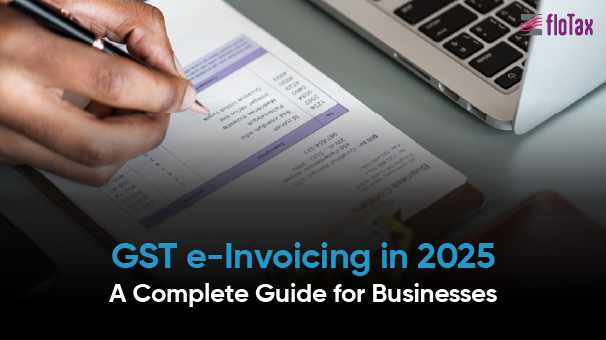Businesses in India are increasingly recognizing the advantages of e-invoicing as it simplifies compliance, enhances operational efficiency, and reduces errors in tax reporting. Introduced as part of the Government’s “Digital India” initiative, GST e-invoicing is a shining example of how technology and commerce can work together to modernize taxation and business practices.
This transformative system is set to redefine how businesses handle B2B and B2C invoicing by synchronizing tax reporting and input credit processes. With the current threshold for mandatory e-invoicing set at ₹10 crores and expected to drop to ₹5 crores, it’s clear that this innovation is not just for large enterprises anymore—it’s for all businesses aspiring to stay competitive and compliant in an increasingly digital economy.
As we look ahead to 2025, understanding and adopting GST e-invoicing has never been more critical. This guide aims to help businesses navigate this technological tax revolution, empowering them to adapt seamlessly and benefit from the opportunities it brings.
What is GST e-Invoicing?
GST e-invoicing isn’t just another digital initiative by government – it’s a revolutionary approach to invoice management & tax compliance. Unlike traditional invoicing systems, GST e-invoicing doesn’t generate invoices but rather validates them through the GST e-invoicing portal (Invoice Registration Portal or IRP). When a business submits invoice details to the GSTN portal, they receive a digitally signed invoice complete with a QR code and a unique Invoice Reference Number (IRN). This system ensures authenticity and creates a standardized format across the entire GST ecosystem.
Current Applicability
As of 2025, GST e-Invoicing is mandatory for businesses with Aggregate turnover exceeding ₹10 Crores. The threshold has been reduced to ₹5 Crores since August 1, 2023.
What Transactions Require e-Invoicing?
E-invoicing is mandatory for:
- B2B transactions
- Business-to-government sales
- Export transactions
- Deemed exports
- Supplies to SEZ
- Inter-state stock transfers
- Services to distinct persons
- Transactions with SEZ developers
Who Needs to Comply?
Mandatory Implementation
GST e-invoicing is mandatory for businesses exceeding specified turnover thresholds, with implementation phases as follows:
- ₹500 crore and above: Since October 1, 2020
- ₹100 crore and above: Since January 1, 2021
- ₹50 crore and above: Since April 1, 2021
- ₹20 crore and above: Since April 1, 2022
- ₹10 crore and above: Since October 1, 2022
- ₹5 crore and above: From August 1, 2023
Notable Exemptions
Some businesses are exempt from e-invoicing requirements:
- Insurance companies
- Banking and financial institutions (including NBFCs)
- Goods Transport Agencies (GTA)
- Passenger transportation service providers
- Multiplex cinema service providers
- SEZ units
- Government departments and local authorities
- OIDAR service providers
Key Benefits for Businesses
1. Operational Efficiency
The transition to e-invoicing brings improvements in operational efficiency. Businesses can experience significant time & cost savings through:
- Elimination of paper-based processes
- Reduction in manual data entry requirements
- Streamlined document management
- Automated data flow across systems
Moreover, the automated e-invoicing software in India significantly reduces human errors, resulting in more accurate financial records and enhanced business intelligence.
2. Compliance and Security
E-invoicing has revolutionized how businesses approach tax compliance. The system offers:
- Standardized invoice formats across the GST ecosystem –
- Automatic population of GSTR-1 returns
- Real-time verification capabilities
- Enhanced protection against fake invoices
These features not only simplify compliance but also provide better security and transparency in business transactions.
3. Business Process Improvements
Beyond compliance, e-invoicing delivers tangible business benefits:
- Enhanced customer service through instant digital delivery
- Real-time tracking of invoices and payments
- Improved cash flow management through faster processing
- Environmental benefits from reduced paper usage
- Better inventory management & supply chain visibility
Implementation Guide
Technical Requirements
Successful e-invoicing implementation requires attention to technical details:
- Standard format compliance with all mandatory fields
- QR code generation capabilities
- Integration with existing accounting systems
- Access to IRP portal through web interface or API
- Proper documentation management systems
Best Practices
To ensure smooth e-invoicing operations:
- Generate e-invoices immediately after creating regular invoices
- Maintain proper documentation for all transactions
- Regular reconciliation of e-invoice data with GST returns
- Train staff on proper e-invoicing procedures
- Implement proper backup and storage systems
Common Issues and Solutions
Understanding common challenges can help businesses navigate e-invoicing more effectively:
1. Cancellation Rules
- E-invoices can only be cancelled within 24 hours of generation
- Partial cancellation is not permitted
- Post 24 hours, cancellations must be reported in GSTR-1
2. Documentation Requirements
- Physical copies of invoices are not mandatory during transportation
- Digital copies are sufficient for compliance
- No requirement for multiple copies (original, duplicate, triplicate)
3. Penalties
- Non-generation of e-invoice: Higher of 100% tax due or ₹10,000
- Incorrect invoicing: ₹25,000 per invoice
4. Threshold Calculations
- Calculated at PAN level, not individual GST registration
- Based on the aggregate turnover of the previous financial year
Looking Ahead
With over 700 Crore e-invoices issued by 11.35 lakh suppliers to 137 lakh recipients between October 2020 and October 2024, e-invoicing has proven to be a transformative force in India’s tax administration. As the system continues to evolve, businesses should stay prepared for potential implementation in the coming financial year.
The shift to e-invoicing represents a significant step towards digital transformation in tax compliance. By embracing this change,floTax by Wepsol is here to help you navigate this digital transformation.
Need assistance with GST e-invoicing? Contact floTax for expert guidance and support in implementing your e-invoicing solution.
Contact us to know more about how we can support your e-invoicing needs.

